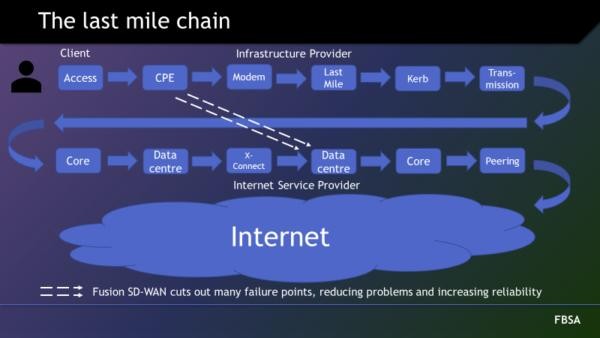🥷The Unseen Culprit | How connectivity blips adversely impact Internet experience 🚑
 Ronald Bartels
Ronald Bartels
In today's fast-paced digital landscape, uninterrupted connectivity is crucial for businesses and individuals alike. However, maintaining consistent internet connectivity, especially over last-mile connections, can be a challenge due to various factors. One of the often overlooked culprits behind last-mile instability is connectivity blips. In this article, we'll delve into what connectivity blips are, how they differ from another types of outages, and how last mile deployment strategies centred around the use of Software Defined Wide Area Networking (SD-WAN) addresses the problem.
There are various types of connectivity blips. These connectivity blips can be either micro-bursts or micro-outages.
We will investigate these various types staring with Micro-bursts and bufferbloat. The major symptom is congestion often represented in video streams as a pause with a circulating animation. Here are some of my favourite examples from a series of MWEB adverts:
There is also this one on Facebook!
Understanding Micro-bursts: Micro-bursts are short bursts of network traffic that exceed the normal data transfer rate over a brief period. These bursts can overwhelm a network network link and lead to packet loss and degradation in network performance. Unlike continuous high traffic, micro-bursts are sporadic and occur for very brief duration, making them challenging to detect
Micro-bursts vs. Bufferbloat: While both micro-bursts and bufferbloat can disrupt network performance, they are distinct issues. Bufferbloat occurs when network buffers fill up due to excessive traffic, causing latency and packet loss. In contrast, micro-bursts happen when a network link experiences a sudden surge in traffic, briefly saturating the link's capacity. This leads to packet loss as well, but it's caused by short bursts rather than persistent congestion.The distinction being that bufferbloat can occur even when a link isn't saturated.
Impact on Last Mile Stability: Micro-bursts can wreak havoc on last-mile stability. In cases where last-mile links are already prone to congestion or limited bandwidth, micro-bursts can exacerbate these issues. This can result in unreliable internet connections, leading to dropped calls in VoIP, video conferencing glitches, and slow-loading web pages.
QoS Strategies to Address Micro-bursts: Quality of Service (QoS) strategies play a vital role in mitigating the impact of micro-bursts on last-mile stability. Here are some key approaches:
Traffic Prioritization: QoS allows you to prioritize critical traffic, such as VoIP or video conferencing, over less time-sensitive data. This ensures that essential services receive preferential treatment during micro-bursts.
Traffic Shaping: Traffic shaping regulates the flow of data to prevent sudden traffic spikes and micro-bursts. This helps maintain a more consistent data rate over the last-mile link.
Buffer Management: Proper buffer management helps control the impact of micro-bursts by intelligently allocating buffer space to manage short bursts of traffic without causing packet loss.
The Role of SD-WAN: SD-WAN (Software-Defined Wide Area Network) solutions are instrumental in addressing micro-bursts and other network performance issues. SD-WAN offers the following benefits:
Queuing strategies: implementing appropriate queuing algorithms that have been updated to mitigate the adverse effects of bufferbloat. Many products especially the ones that have been derived from firewall stacks have not yet been engineered to mitigate bufferbloat.
Dynamic bonding: SD-WAN intelligently distributes traffic across multiple last-mile links, reducing the risk of congestion and micro-bursts on a single link by using multiple aggregated links.
Real-time Traffic Monitoring: SD-WAN constantly monitors network performance, detecting micro-bursts and adapting traffic in real-time to minimize their impact.
Application-Based Routing: SD-WAN can route traffic based on the specific needs of applications, ensuring that identified critical services remain unaffected during micro-bursts.
Micro-bursts may be invisible to the naked eye, but their impact on last-mile stability can be significant. Understanding the difference between micro-bursts and bufferbloat and implementing QoS strategies, especially through SD-WAN solutions, can help businesses maintain reliable internet connectivity, even in the face of these hidden disruptions.
The effects of micro-outages are different to micro-bursts as discussed above as they are short periods of actual outages in the connectivity links themselves resulting in short periods of no traffic forwarding as opposed to just congestion of the latter. Crucially micro-outages can occur on either fibre or wireless.
There is a common misnomer that fibre never fails. Let address the elephant in the room and discuss how fibre fails.
Fibre maintenance: Adds moves and changes require a truck roll to a manhole or handhold. In these locations there will be a cassette that needs to be removed, fibre paths adjusted and then reinserted. During these periods there is a ripple effect of downstream connectivity blips as the fibre is flexed.
Dust: We live on Earth and its a dusty place. Dust will over time settle on everything including fibre. Eventually, it moves into the connector and has a habit of finding the polished surface of the fibre termination and causing a resultant distribution in signal.
3rd Party interference: Backhoes are notorious for digging up fibre around the world and it will continue to happen as no operator has a pro-active deployment strategy to prevent this type of incident. Make no mistake, a solution exists, The Mind-Blowing Innovation of Distributed Acoustic Sensing (DAS) but none have implemented it!
Power problems: Power problems trigger the loss of the active fibre equipment meaning the connectivity is dead in the water. In South Africa we are regularly cursed with loadshedding but this isn't a problem restricted to ourselves. In other parts of the world adverse weather conditions and storms trigger power outages which has the same effect.
Age of the plant: The average age of a fibre plant is 20 to 25 years. The prevalence of fibre failures will soon dramatically increase as the Bell curve hits. It already starting with the fibre plants of early adopters.
Backhaul failures: There are more than a dozen points of failure in a fibre connection from the user to the Internet. That this decks of cards remains up and running for extended periods of time is a modern miracle. One of the most common problems is an outage between the operate point of presence and their data centre. Although the operator might have multiple links, due to economic factors they don't provision for failure situations meaning that even a single failure results in an over-subscription of bandwidth.

- Routing protocols: The convergence times of routing protocols are not instantaneous. BGP takes up to 4 minutes and even when using OSPF there is a clear impact of sessions being dropped and re-established. Even strategies using ECMP and not bulletproof causing blips multiple times a day.
Micro-outages also occur on wireless. Let us dig in:
Fibre: Most wireless links eventually transit to a fibre backhaul. It stands to reason that a fibre problem will also trigger a visible problem on the wireless.
Interference: This can be either self interference due to poor planing or induced by a 3rd party. There are numerous signal related interference problems while less in regulated spectrum its amplified in public use spectrum such as WiFi.
Obstruction: The most common example is foliage. However, I've seen everything from a crane to a container ship causing wireless links failing.
Storms: In our neck of the woods we have storms that move in from the west. As these storms move over the Highveld the wireless links fail and recover as they impact the signal. A strong wind and poor mounting will also result in the misalignment of radio pairs.
Handoff: I major problem in mobile networks, signal handoff between towers triggers faults. This also happens on units at fixed location as towers have signal breathing where coverage is impacted by usage and capacity. In low earth orbit (LEO) satellite solutions the same issue occurs during signal movement from one satellite to another.
These micro-outages in both fibre and wireless are mitigated by Fusion's SD-WAN. The sweet spot is to combine both a fibre and wireless link together into a bonded aggregated last mile solution. Does it eliminate fully micro-bursts or micro-outages. No, but it reduces the probability of an occurrence impacting services to as close to zero, guaranteeing best in class uptimes. The reason being the systems is able to identify and detect these problems and mitigating them seamlessly using instantaneous path correction and steering abilities.
Ronald Bartels ensures that Internet inhabiting things are connected reliably online at Fusion Broadband South Africa - the leading specialized SD-WAN provider in South Africa. Learn more about the best SD-WAN in the world: 👉 Contact Fusion
Subscribe to my newsletter
Read articles from Ronald Bartels directly inside your inbox. Subscribe to the newsletter, and don't miss out.
Written by

Ronald Bartels
Ronald Bartels
Driving SD-WAN Adoption in South Africa